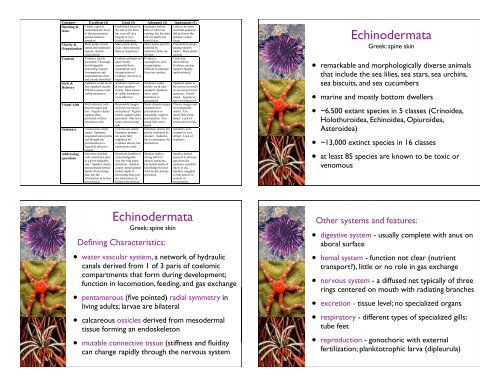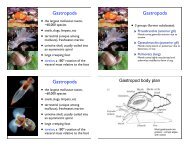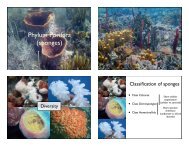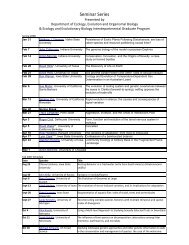Echinodermata Echinodermata
Echinodermata Echinodermata
Echinodermata Echinodermata
Create successful ePaper yourself
Turn your PDF publications into a flip-book with our unique Google optimized e-Paper software.
Rubric for evaluating NEWS REPORTS, EOSC 310<br />
Use this rubric as a guide. Write the categories (left side) on your index card. Evaluate each category on a<br />
scale of 0-4. Write comments on reverse side of card.<br />
Category Excellent (4) Good (3) Adequate (2) Inadequate (1)<br />
Opening &<br />
intro<br />
Clearly, quickly<br />
established the focus<br />
of the presentation,<br />
gained audience<br />
attention<br />
Established focus by<br />
the end of the intro,<br />
but went off on a<br />
tangent or two.<br />
Audience had an<br />
idea of what was<br />
coming, but the intro<br />
did not clarify the<br />
Little or no intro,<br />
such that audience<br />
did not know the<br />
speaker’s main<br />
Gained attention. main focus. focus.<br />
Clarity & Main points clearly Main points fairly Main points must be Presentation jumps<br />
Organization stated and explained;<br />
logical, smooth<br />
clear; some missing<br />
links or transitions.<br />
inferred by<br />
audience; holes are<br />
among random<br />
topics. Main points<br />
organization<br />
evident.<br />
unclear<br />
Content Evidence clearly Evidence perhaps not Evidence,<br />
Lacks key<br />
presented. Thorough, quite clearly assumptions, and observations.<br />
knowledgeable separated from interpretation Evidence unclear.<br />
interesting, logical. assumptions and difficult to untangle Appears largely<br />
Assumptions and interpretation of from one another. opinion-based.<br />
interpretations clear, evidence, but story is<br />
and clearly identified. logical.<br />
Style & Audience could see & Audience could see Audience could Speakers spoke to<br />
Delivery hear speakers clearly.<br />
Effective pauses and<br />
& hear speakers<br />
clearly, Most pauses<br />
mostly see & hear<br />
speakers. Speakers<br />
the screen or mostly<br />
to one person in the<br />
verbal intonation. & verbal intonation show some audience. Poorly<br />
were effective. hesitation or timed. Appears to<br />
uncertainty. have not practiced.<br />
Visual Aids Well-selected, well- Reasonable images Some chosen images Chosen images and<br />
placed images and and text, not always extraneous to text marginally<br />
text. Figures clearly well-placed. Figures presentation or useful. Too<br />
support ideas clearly support ideas marginally support much/little extra<br />
presented without presented. May have presentation. Too detail. Lack of<br />
extraneous info. some extra/missing much/little extra connection to topic.<br />
info<br />
detail.<br />
Summary Conclusions clearly Conclusions stated. Summary shown but Summary non-<br />
stated. Summary Summary perhaps poorly explained by existent or very<br />
integrated main points not quite fully speaker. Audience abrupt. Lack of<br />
and brought the supported by has to summarize for synthesis.<br />
presentation to a evidence shown, but themselves.<br />
logical & effective<br />
closure<br />
main points clear.<br />
Addressing Questions handled Questions handled in Speaker made a Speaker lacked<br />
questions with confidence and<br />
in a knowledgeable<br />
a knowledgeable<br />
way but with some<br />
strong effort to<br />
answer questions,<br />
answers to obvious<br />
questions the<br />
way. Speaker clearly hesitation. Speaker but lacked depth of audience would be<br />
demonstrated further clearly demonstrated knowledge beyond likely to ask.<br />
depth of knowledge further depth of what he/she already Speaker struggled<br />
than just the<br />
knowledge than just presented.<br />
to link answer to<br />
information in his/her the information in<br />
content of<br />
presentation. his/her presentation.<br />
presentation.<br />
<strong>Echinodermata</strong><br />
Greek: spine skin<br />
Defining Characteristics:<br />
• water vascular system, a network of hydraulic<br />
canals derived from 1 of 3 paris of coelomic<br />
compartments that form during development;<br />
function in locomotion, feeding, and gas exchange<br />
• pentamerous (five pointed) radial symmetry in<br />
living adults; larvae are bilateral<br />
• calcareous ossicles derived from mesodermal<br />
tissue forming an endoskeleton<br />
• mutable connective tissue (stiffness and fluidity<br />
can change rapidly through the nervous system<br />
<strong>Echinodermata</strong><br />
Greek: spine skin<br />
• remarkable and morphologically diverse animals<br />
that include the sea lilies, sea stars, sea urchins,<br />
sea biscuits, and sea cucumbers<br />
• marine and mostly bottom dwellers<br />
• ~6,500 extant species in 5 classes (Crinoidea,<br />
Holothuroidea, Echinoidea, Opiuroidea,<br />
Asteroidea)<br />
• ~13,000 extinct species in 16 classes<br />
• at least 85 species are known to be toxic or<br />
venomous<br />
Other systems and features:<br />
• digestive system - usually complete with anus on<br />
aboral surface<br />
• hemal system - function not clear (nutrient<br />
transport?), little or no role in gas exchange<br />
• nervous system - a diffused net typically of three<br />
rings centered on mouth with radiating branches<br />
• excretion - tissue level; no specialized organs<br />
• respiratory - different types of specialized gills;<br />
tube feet<br />
• reproduction - gonochoric with external<br />
fertilization; planktotrophic larva (dipleurula)
Class Asteroidea (sea stars)<br />
• star-shaped, free moving, pentamerous animals<br />
• hollow arms project from a central disc<br />
• range from 2 cm to ~1 m in diameter<br />
• occur worldwide, largely in coastal waters<br />
• ~ 1500 species<br />
Asteroidea<br />
Water-Vascular System<br />
• consists of the hydraulic tube feet and internal coelomatic canals<br />
• canals: circumoral ring canal, radial canals, lateral canals, stone canal<br />
(opens aborally into a small chamber, madreporic ampulla, which joins the<br />
madreporite)<br />
• the WVS is lined by a myoepithelim and thus is ciliated and muscular<br />
Class Asteroidea (sea stars)<br />
• the mouth is located centrally on the underside of the disc (oral<br />
surface)<br />
• a large furrow (ambulacrum) extends radially from the mouth along<br />
each arm<br />
• each ambulacrum contains two or four rows of tube feet<br />
• the upper (aboral) surface bears an anus (when present) and a large,<br />
button-like madreporite (a sieve plae)<br />
Asteroidea<br />
Water-Vascular System<br />
Ampulla<br />
Ossicle<br />
Tube foot<br />
Sucker<br />
• each lateral canal has a valve and terminates in an ampulla and a tube<br />
foot (x40,000!)<br />
• the ambulacral ossicles form the floor of the ambulacral groove<br />
• longitudinal muscles of the ampulla contract => foot’s extension +<br />
attachment => longitudinal muscles of the foot contract => pulling<br />
force => detachment<br />
• adhesion is largely chemical, but adhesion by suction may also occur
Asteroidea<br />
Water-Vascular System<br />
• each lateral canal has a valve and terminates in an ampulla and a tube<br />
foot<br />
• the ambulacral ossicles form the floor of the ambulacral groove<br />
• longitudinal muscles of the ampulla contract => foot’s extension +<br />
attachment => longitudinal muscles of the foot contract => pulling<br />
force => detachment<br />
• adhesion is largely chemical, but adhesion by suction may also occur<br />
Asteroidea<br />
Digestive system<br />
• most of the space in the disc and arms is occupied by digestive system<br />
• the mouth opens into a short esophagus that leads to a large stomach<br />
• the stomach is divided by a horizontal constriction into a large, oral<br />
cardiac stomach and a smaller aboral pyloric stomach<br />
• pyloric stomach receives ducts from a pair of pyloric ceca in each arm<br />
• pyloric seca are elongate, hollow, branched extensions of the stomach<br />
Radial canal<br />
Tube foot<br />
Perivisceral<br />
coelom<br />
Pyloric cecum<br />
Pyloric stomach<br />
Anus<br />
Mouth<br />
Ring canal<br />
Cardial stomach
Asteroidea<br />
Nervous system<br />
• the peripheral nervous system includes two intraepithelial nets,<br />
the sensory ectoneural system in the epidermis and the motor<br />
hyponeural system in the coelomic lining<br />
• the CNS consists of ectoneural and hyponeural circumoral<br />
nerve rings and radial nerves<br />
• The motor component of the radial nerve innervates the<br />
ampullae, tube feet, and body-wall muscles, while the sensory<br />
part receives input from the sense cells and organs<br />
• no ganglia, no glea<br />
Asteroidea<br />
Hemal system<br />
• three interjoined radial sets of<br />
vessels, each consisting of a hemal<br />
ring around the gut and five<br />
sometimes branched radial vessels<br />
• the hyponeural hemal ring, the<br />
gastric hemal ring, and the genital<br />
hemal ring<br />
• Two specialized vessels called<br />
gastric hemal tufts cross the<br />
perivisceral coelom and unite the<br />
gastric hemal ring with the axial<br />
hemal vessel and heart<br />
• the three hemal rings are united<br />
by the vertical axial hemal vessel<br />
(axial gland) that lies in the wall of<br />
the axial canal<br />
Ectoneural<br />
nerve net<br />
Hyponeural<br />
nerve net
3 Bilateral symmetry<br />
Anteroposterior body organization<br />
Medial nerve cord<br />
Gut and CNS parallel<br />
Complex life cycle with larva<br />
Ciliated band in larva<br />
b<br />
1 Brachiolar complex (larva)<br />
2 Rudiment ectoderm invaginates<br />
3 Cilated band rearranged in larva<br />
4 Radial symmetry<br />
Loss of cephalization and brain?<br />
Radial nerve cords<br />
Gut and CNS orthogonal<br />
Water vascular system with podia<br />
Calcareous endoskeleton<br />
Metazoa<br />
Regeneration and clonal reproduction<br />
Larvae<br />
Adults<br />
feather stars sea stars brittle stars sea urchins sea cucumbers<br />
Morphology<br />
(Crinoidea) (Asteroidea) (Ophiuroidea) (Echinoidea)<br />
Genes : sites of expression<br />
Asterozoa<br />
Echinodermat<br />
Eleutherozoa<br />
ry history of body architecture and regulatory genes within the<br />
hinodermata (b). Reconstructed changes in morphology (left)<br />
mental roles and expression domains of regulatory genes<br />
he expression domains and roles of several regulatory genes<br />
ropods and chordates (a, 8) 8–11 , despite their phylogenetic<br />
orphological disparity 2,5,6 . These similarities probably reflect<br />
architectural features, such as bilateral symmetry and an<br />
is (a, 3) between protostomes and deuterostomes. Morpholo-<br />
istinguish phyla (such as a,1) and groups of related phyla( a, 2)<br />
ome such cases, changes in the developmental roles of<br />
, 5 and 7) have been identified that may have been involved<br />
e derived structures 9,10,17 . The origin of echinoderms followed<br />
rthropods and chordates, and involved substantive modifica-<br />
?<br />
Echinozo<br />
Sexual reproduction and<br />
development<br />
7 Hox cluster domains along A/P axis<br />
distal-less anterior CNS<br />
engrailed ganglia along CNS<br />
orthodenticle<br />
8 Hox genes domains along A/P axis<br />
5 orthodenticle ciliated band (larva)<br />
6 engrailed rudiment invagination<br />
7 distal-less brachiolar arms (larva)<br />
distal-les subtrochal cells (larva<br />
8 engrailed ectoderm<br />
(skeletogenesis)<br />
orthodenticle podia<br />
distal-les podia<br />
tions in basic body architecture (b, 2) 1–6 ; already present was a complex life cycle<br />
involving a larva that fed using a ciliated band (a, 3) 1–6 . Data reported here and<br />
taken from the literature 8–11,19 allow us to reconstruct changes in the expression<br />
domains of three regulatory genes during the origin and radiation of echino-<br />
derms. Several derived features of gene expression are shared by asterozoan<br />
and echinozoan echinoderm species (b, 7), implying that they were present<br />
before the divergence of these clades over 490 Myr ago 22 . The origin of these<br />
features could be even earlier (arrow near base of cladogram), but expression<br />
data are currently unavailable for crinoids, the most basal clade of extant<br />
echinoderms. Other features of gene expression appear to be limited to a<br />
single class (such as b, 4 and 6), suggesting later origins or subsequent losses<br />
within other lineages. Phylogenetic relationships are from refs 2, 6, 7 and 14.<br />
Egg Embryo Early larva Late larva Juvenile<br />
bilaterally symmetrical<br />
of echinoderm development. Echinoderm embryos and larvae<br />
etrical 1,6,16 . In late larvae, discrete populations of ectodermal<br />
cells on the left side of the body proliferate to form the<br />
ent (green crescent). The first radially symmetrical structures<br />
udiment (disc near late larva). During metamorphosis, many<br />
left-right asymmetrical<br />
radially symmetrical<br />
Echinoderm embryos and larvae are bilaterally symmetrical. In<br />
late larvae, discrete populations of cells on the left side of the<br />
body proliferate to form the imaginal adult rudiment. During<br />
metamorphosis, the rudiment gives rise to much of the radially<br />
metamorphosis.<br />
symmetrical juvenile (green).<br />
Lowe and Wray, 1997 Nature<br />
larval tissues (blue) are lost, and the rudiment gives rise to much of the juvenile<br />
(green). Domains of regulatory gene expression fall into three distinct symmetry<br />
classes: bilateral in embryos and early larvae; left–right asymmetric in late larvae,<br />
during establishment of the imaginal rudiment; and radial during and after<br />
Nature © Macmillan Publishers Ltd 1997<br />
6 OCTOBER 1997 719<br />
Sexual reproduction and<br />
development<br />
• Asteroids are typically gonochorists with<br />
external fertilization and a complex life cycle<br />
that includes a planktotrophic larva<br />
• Up to 2,500,000 eggs<br />
• Development includes radial cleavage,<br />
regulative development, and enterocoelous<br />
origin of the coelomic cavities<br />
• The bilaterally symmetric, suspensionfeeding<br />
larva (bipinnaria -> brachiolaria)<br />
Class Crinoidea<br />
crown<br />
stalk<br />
• The main part of the body is supported above the substrate<br />
either by a long stalk or by a series of grasping claws (cirri)<br />
• suspension feeders with mouth oriented upward<br />
• feather starts and sea lilies (~700 species)<br />
cirri
Class Echinoidea [“spine-like”]<br />
• Lack arms; the ambulacra and oral surface expanded aborally to cover<br />
most of the body<br />
• ossicles are joint to form a rigid test (like a shell but internal)<br />
• podia pores pass through the ambulacral plates<br />
• adults generally possess an Aristotle’s lantern - a complex system of<br />
ossicles and muscles used for grazing and chewing<br />
• ~1000 species<br />
Class Ophiuroidea [“snake-like”] (Brittle stars)<br />
• Well-developed ossicles in the arms form a linear series of articulating<br />
“vertebrae” joined together by connective tissue and muscles<br />
• the oral surface bears 5 pair of invaginations (bursal slits), which may serve<br />
for gas exchange and as brood chambers for embryos<br />
• ~2100 species<br />
Class Holothurioidea (sea cucumbers)<br />
buccal podia<br />
• The body is worm-shaped, elongated along the oral/aboral axis<br />
• approximately one-third of species live in the deep sea, where they account<br />
for up to 90% of benthic biomas<br />
• the calcareous ossicles are reduced in size and embedded in the body wall<br />
• highly branched, muscular respiratory structures extend from the cloaca<br />
into the coelomatic cavity (respiratory tree)<br />
• ~1200 species
NATURE | VOL 392 | 5 MARCH 1998<br />
b<br />
Ciliated band in larva<br />
1 Brachiolar complex (larva)<br />
Larvae<br />
Adults<br />
feather stars sea stars brittle stars sea urchins sea cucumbers<br />
Morphology<br />
(Crinoidea) (Asteroidea) (Ophiuroidea) (Echinoidea) (Holothuroidea)<br />
Genes : sit<br />
2 Rudiment ectoderm invaginates<br />
3 Cilated band rearranged in larva<br />
4 Radial symmetry<br />
Loss of cephalization and brain?<br />
Radial nerve cords<br />
Gut and CNS orthogonal<br />
Water vascular system with podia<br />
Calcareous endoskeleton<br />
Asterozoa<br />
<strong>Echinodermata</strong><br />
Lowe and Wray, 1997 Nature<br />
Eleutherozoa<br />
?<br />
Echinozoa<br />
Eleuterozoa<br />
Nature © Macmillan Publishers Ltd 1998<br />
Echinozoa<br />
Cryptosyringida<br />
8 Hox genes do<br />
5 orthodenticle<br />
6 distal-less<br />
7 distal-less<br />
distal-less<br />
8 engrailed<br />
orthodenticle<br />
distal-less





